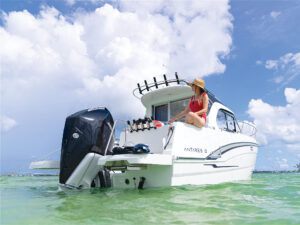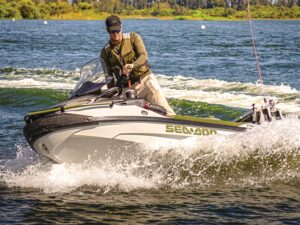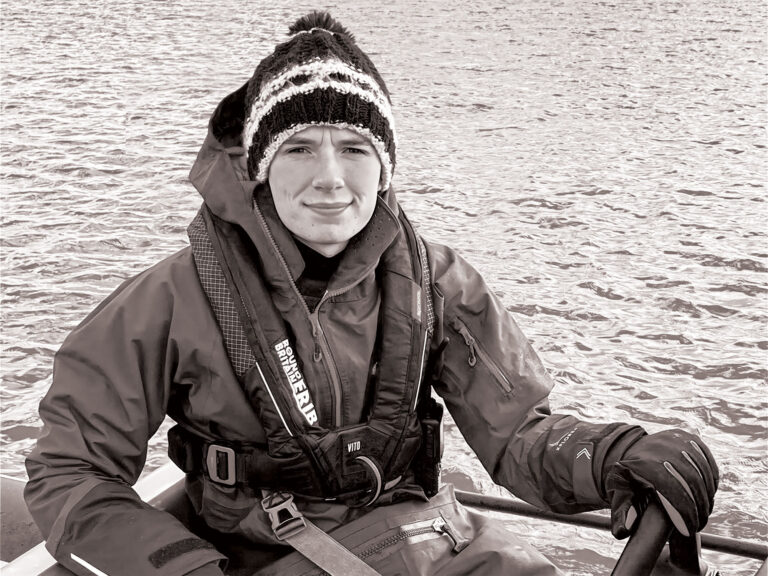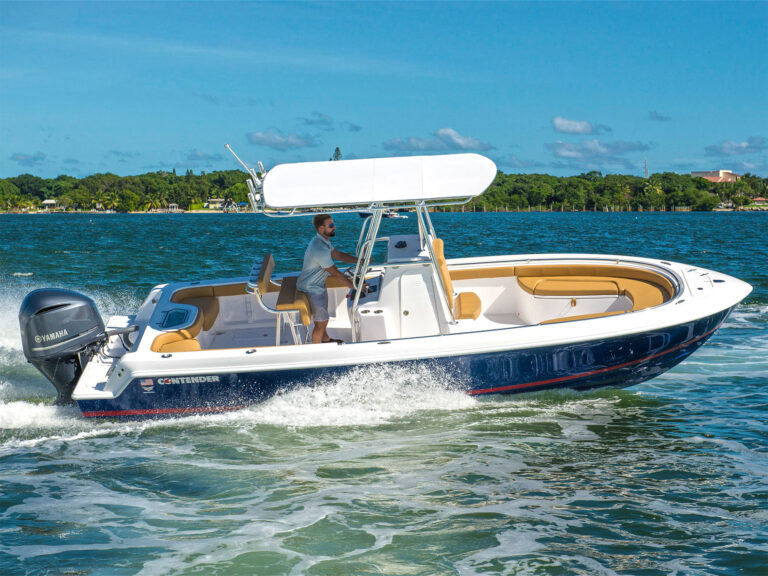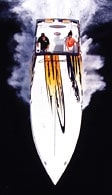
Cigarette 42
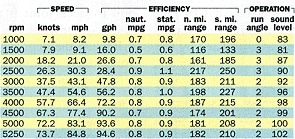
Cigarette 42 Specs

Cigarette 42
Charging across the water at 80 mph Cigarette 42 Tiger TS, I glanced at my inclinometer (ride-angle indicator) and was surprised by the two-degree reading. Most stepped hulls ride flat, producing a reading of zero or one. But from 3500 rpm and 54.6 mph all the way up to the top speed of 84.8 mph at 5250 rpm, the 42 Tiger TS had the meter stuck at two degrees.
Something was up – and it was the bow. Cigarette added 5″ of rocker in the 42 Tiger TS’ bottom aft of the second step so the boat rocks back when it gets up to speed and flies the bow over the waves rather than through them.
With a pair of 550-hp Mercury Racing HP575SCi engines ($82,080) mated to Bravo One XR drives, our test boat ran a 84.8-mph top speed, which is hyperquick for a 9,800-pound 42′ boat with twin engines. And that was on a hot, humid day on sticky-smooth water. I bet if we were running in about 6 to 12 inches of chop, we would have seen a range in the high 80s.
Part of the reason the boat can make the most out of the test power is because every excess ounce of fat has been sucked out of it. Cigarette uses a vacuum-bagged balsa core that’s 1″ thick in the hull bottom and 3/4″ in the hullsides to back up the bi- and tridirectional fiberglass and vinylester resin. Except for the engine compartment stringers, which are wood, longitudinal members are preformed foam?filled fiberglass, and the bulkheads are made with Baltek DecoLite panels. The shoebox-lid-style hull-to-deck joint is through-bolted and bonded with fiberglass for durability.
THE HIGHS: Rides as smooth as a limo through anything at 80 mph. Integrated Harwood scoops in engine hatch are way cool. Shutoff valves for strainers are smart for safety and easy maintenance.** **
THE LOWS: Narrow beam means a narrow cockpit and interior. Needs fold-down steps to make it easier to get down into the engine compartment. Bolsters are uncomfortable to sit in.
Because the steps are only about an inch or two tall, they put enough air under the boat to break friction with the water but not so much that the boat’s ride is upset. The 42 Tiger TS’ bottom has inner strakes that end at the first step, while the outer strakes run full-length. To give the boat better grip in turns, the outer strakes and the chines are reversed, or turned down a few degrees. In slalom and circle maneuvers, the tweaked strakes and chines worked to perfection, giving the boat agility that’s rare in a 40-plus-foot hull. Other smooth-handling boats in this size range include Wellcraft’s 43 Scarab AVS, which retails for $406,770 with the same power as our test boat and runs in the low to mid-80s. If you prefer to go nonstepped, Baja’s 40 Outlaw is a bargain at $297,583 with twin 575SCi’s, but it tops out at about 80 mph.
THE SKINNY. Because the 42 Tiger TS is an updated version of an older hull, it retains the narrow-by-today’s-standards 8′ beam, which is a disadvantage when it comes to interior space. The 43 Scarab AVS measures 8’9″ at the beam, while the 40 Outlaw spans 8’6″. That means more space in the cockpit and belowdecks. For example, both wider boats have gunwale stowage, but the 42 Tiger TS doesn’t have the width to offer the extra capacity. Our test boat’s bench seat, on the other hand, is nice and deep with amply padded upholstery and stowage in the base. Kudos to Cigarette for protecting the speaker backs and wiring and the battery cables with molded plastic covers so contents of the bench locker don’t damage them. I also like that the engine hatch hydraulic pump is in the bench seat locker so you can get to it with jumper cables in the event of a battery failure.
The bolsters are secured with bolts driven into tapped 1/4″ aluminum plates that are fiberglassed in place in the cockpit sole. Both have manual dropout cushions, but when I rode in them with the cushion in the “up” position, I felt as if I were being pushed out of the seat. Standing, they were fine.
Ahead of the copilot’s bolster is a chart table. Cigarette also put the volt and fuel gauges in the port dash, angling them to starboard so the driver can see them. There is a small glovebox that opens to a much larger, deeper draining box. To starboard, the helm features full hydraulic Mayfair steering and the balance of the Gaffrig gauges, which again are in angled bezels for optimum driver visibility. The top of the panel has a GPS/chartplotter and Ritchie electronic compass. Also up high on the panel are the Gaffrig liquid-filled speedometer and tachometers. Instruments, including those for oil and water temperature and pressure, supercharger boost, and fuel pressure, are grouped in columns on each side of the steering wheel. Because it’s hard to hear audio alarms when you’re running, there’s also a large red warning light for each gauge cluster that illuminates if pressures drop or temperatures climb. Rubber-booted accessory switches are easy to reach.
With the bolster providing the perfect armrest, throttling this boat is super comfortable. The levers are fitted with a single drive-trim button with individual switches for the drivers and tabs on the port side of the wheel. Mechanical trim indicators are just ahead of the throttles. In a clutter-reducing move, all the circuit breakers for the accessory switches are down low ahead of the driver’s shins. This also protects them from spray and weather. Smart.
Realizing that few people who buy this boat plan to overnight in it, Cigarette placed a priority on the belowdecks facing lounges, each of which measures 7’8″ long and has stowage in the base. The head is between the forward ends of the lounges in a molded fiberglass console. All the way forward, the V-berth cushion is 4’9″ long and 6’2″ wide, and for weight savings, the pad is supported on suspended trampoline fabric that’s tied to the bulkhead. A small galley includes a sink and cooler.
GOT THE LOOK. Nothing says high performance like a pair of Harwood Pro-Stock-style air-intake scoops on a boat’s engine hatch, but that usually means no padded sunlounge. Cigarette integrates the scoops into the cushioning so you get the necessary air to the motors and still have a place to stretch out. The hatch is fitted with the requisite mirrors on the underside to show off the motors, but when it’s open, you’re faced with a long drop from the deck to the engine compartment sole. Getting down there means stepping on top of the custom aluminum battery boxes. I’d install fold-down steps on the firewall bulkhead to make the descent safer.
The twin 575SCi’s are installed on cradle mounts through-bolted to aluminum L-angles that are through-bolted to the stringers with backing plates. Trim pumps are easily serviced on the firewall bulkhead. All hoses and wires are run along the starboard gunwale in PVC tubing, and in the engine compartment they’re supported with stainless-steel cushioned clamps.
Mayfair sea strainers keep debris from getting into the motors. If a hose breaks, close the shutoff valves mounted before the strainers so the bilge won’t flood. To leave the boat in the water overnight, close the seawater intake, hook up a hose, and flush the engine with fresh water.
LAST WORD. A stepped-hull offshore go-fast that can run wild in the untamed ocean.
LOA……….41’7″ ** **
Beam……….8’0″ ** **
Draft……….3’0″ ** **
Displacement (lbs., approx.)……….9,800 ****
Transom deadrise…22° ****
Bridge clearance…5’9″ ****
Minimum cockpit depth ……….3’1″ ****
Max. cabin headroom ……….4’8″ ****
Fuel capacity (gal.)…260
Water capacity (gal.)..10 ****
Price (w/standard power) ……….$313,198
Price (w/test power) ……….$395,278 ****
STANDARD POWER: Twin 375-hp MerCruiser 496 MAG Bravo One V-8 gasoline stern drives. ****
OPTIONAL POWER: Twin V-8 gasoline stern drives up to 2,000 hp total.
TEST BOAT POWER: Twin 550-hp Mercury Racing HP575SCi Bravo One XR gasoline stern drives with 502 cid, 4.47″ bore x 4.00″ stroke, swinging 15 1/4″ x 30″ Mercury Racing Bravo One four-bladed ss props through 1.5:1 reductions.
STANDARD EQUIPMENT (major items): Through-bolted ss hardware w/backing plates; twin batteries in custom aluminum boxes; 2 battery switches; heavy-duty K-Plane trim tabs; ss external tie-bar; dual 1,500-gph bilge pumps; bilge blowers; Gaffrig instrumentation w/warning lights; nav lights; Zero Effort shifts and throttles; aluminum bow- and sternrails; battery charger and shorepower; power engine hatch; halogen engine room light; hydraulic steering; fuel/ water separators; 2 deck hatches; standup bolsters; cabin lighting; 12v outlet; Alpine AM/FM/CD stereo; galley w/sink and removable cooler; head; transom shower; fuel vapor sniffer; 2 handheld fire extinguishers; auto. fire extinguisher; anchor, chain, and rode; emergency shutoff switches; C0 detector.

